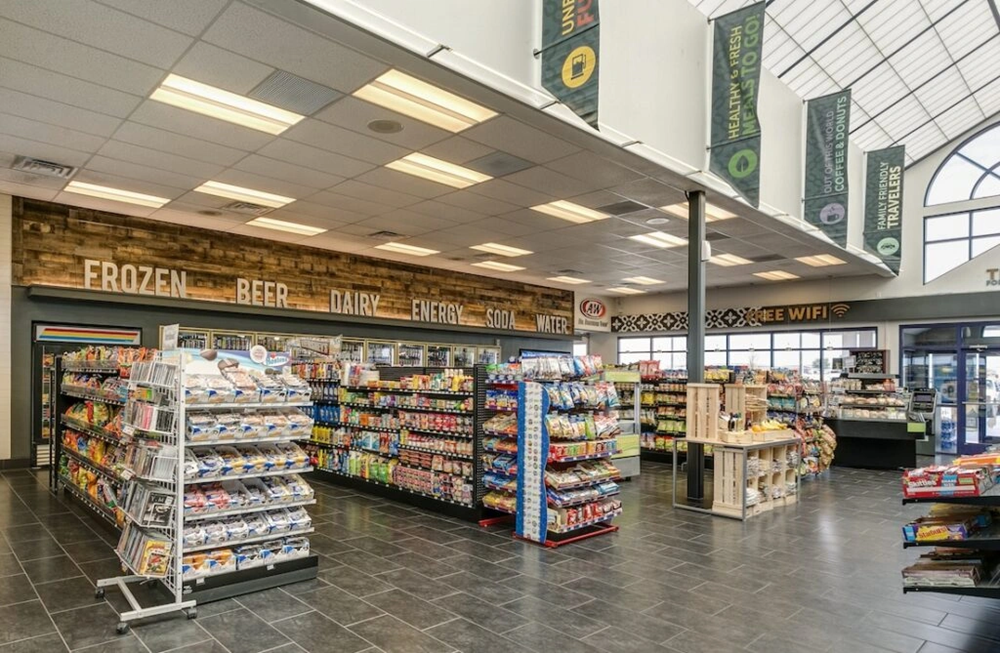
Supermarket shelving systems form the structural foundation of retail operations across global markets. Gondola shelving remains the predominant fixture type used in contemporary supermarket installations. These commercial-grade display units serve dual functions—product storage and customer behavior modification through strategic merchandise presentation.
Retail establishments depend on systematic shelving configurations to maintain inventory accessibility while optimizing floor space utilization [61]. Modern grocery store fixtures strike a balance between storage capacity and product visibility requirements. This operational efficiency directly correlates with sales performance metrics. Store configurations require specialized display solutions—refrigerated display cases maintain perishable product integrity, while end-cap shelving units occupy premium traffic zones for maximum exposure. Retailers must evaluate multiple fixture specifications when planning store layouts.
This technical analysis covers 13 superior grocery store shelving systems that demonstrate measurable sales increases in 2025. Documentation includes material specifications, placement protocols, and quantified performance impacts for each fixture category.
Gondola Shelving
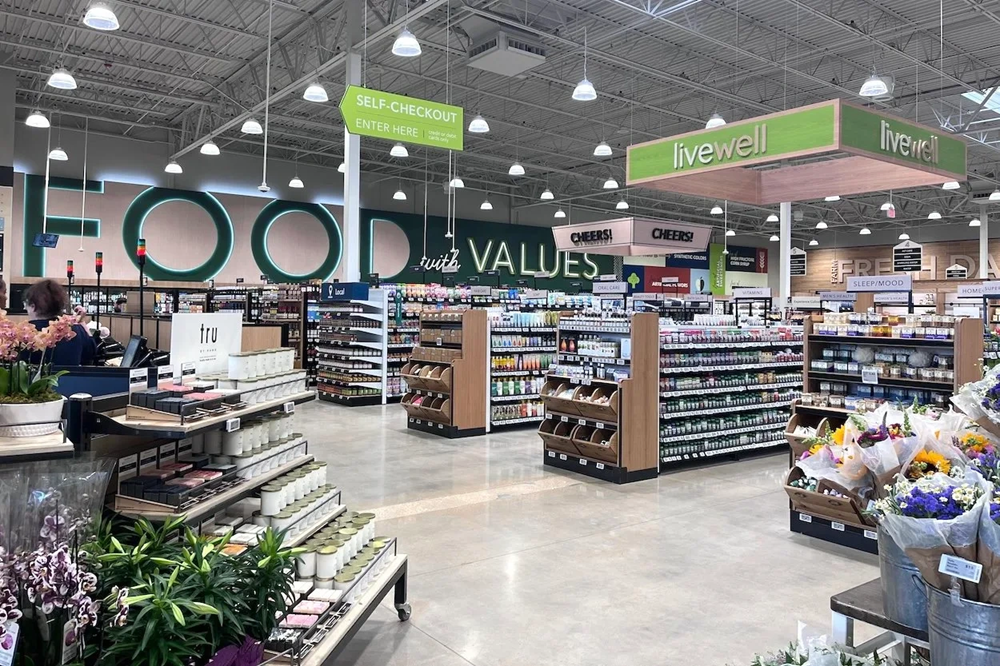
Gondola shelving maintains market dominance with 48% global retail display market share. These freestanding units establish the primary structural framework for merchandise organization in commercial grocery installations.
Gondola Shelving Features
Freestanding gondola systems feature wide base platforms with double-sided vertical support structures enabling shelf extension from single or dual sides. The system eliminates stability concerns associated with wall-mounted alternatives, preventing loose or tilted shelf incidents. Standard specifications include:
- Quick-adjust mechanisms for rapid merchandising transitions
- Heavy-duty weight capacity for dense product categories
- Height adjustment range: 36″-120″ with 6″ increment positioning
- Length configurations: 2-foot minimum to unlimited runs (standard 3-4 foot sections)
- Maximum shelf depth: 30 inches for enhanced storage capacity
Units accommodate accessibility requirements for children and disabled shoppers through adjustable configurations.
Gondola Shelving Materials
Cold-rolled steel construction provides primary structural integrity with precision manufacturing and enhanced mechanical properties. Steel component specifications comprise square tubes (20×20mm to 60×40mm), round tubes (∅15mm to ∅38mm), steel wire (∅2.5-12mm), and steel plates (thickness 0.4-2.0mm).
Wood components utilize finger joint boards, tri-polyamide boards, particleboard, or MDF based on customer specifications. Acrylic applications include partitions, baffles, and storage boxes. PVC components encompass light boxes, spacers, price bars, and related accessories.
Gondola Shelving Placement
Strategic aisle positioning influences customer traffic patterns. Store layouts require clear navigation paths without bottlenecks, directing customers through high-margin product zones. Gondola arrangements establish department boundaries and facilitate intuitive store navigation.
Single-sided configurations maximize wall-adjacent vertical space utilization. Double-sided island units enable dual-access product visibility enhancement. End cap gondolas capture transitional attention between aisle movements.
Gondola Shelving Sales Impact
Eye-level product positioning generates sales increases up to 23%. Gondola endcap displays achieve 10-20% higher sales performance compared to standard shelf facings.
Organized display presentations increase customer purchase probability. Shelf divider implementation reduces restocking time by 30%, maintaining consistent inventory levels. Retail performance studies from 2024-2025 indicate adaptable displays for product launches and seasonal promotions produce measurable sales increases for featured merchandise.
Wall Shelving

Wall-mounted shelving systems utilize perimeter space efficiently through direct wall attachment methods, eliminating floor space requirements while maximizing vertical merchandising capacity [15]. These single-sided display configurations provide structural advantages for retailers implementing space optimization strategies.
Wall Shelving Features
Wall shelving systems operate as single-sided display units designed for heavy merchandise categories, including cleaning products, beverage containers, and canned food inventory. The fixed wall mounting eliminates structural instability common with freestanding alternatives. These fixtures convert unused wall areas into functional merchandising zones. Single-sided access patterns create defined customer traffic flows throughout retail environments.
Wall Shelving Materials
Steel construction dominates wall shelving applications due to superior load-bearing specifications and structural durability. Heavy merchandise categories require robust material properties that steel provides consistently. Wood construction alternatives deliver premium presentation quality at increased cost points. Steel frameworks with wood-grain finishes offer cost-effective solutions that maintain durability standards while providing enhanced visual presentation.
Wall Shelving Placement
Perimeter installation locations create continuous merchandising frameworks throughout store environments [15]. Wall positioning generates natural customer flow patterns between departments. Vertical space utilization maximizes merchandising capacity without reducing floor area availability. Pharmacy sections, grocery departments, and electronics zones benefit from wall-mounted fixture installations.
Wall Shelving Sales Impact
Shelf management protocols directly influence revenue performance through strategic product positioning. Eye-level product placement generates measurable sales increases within customers’ primary visual range. Promotional merchandise requires prominent positioning with clear price signage. Organized shelf presentations without vacant spaces maintain abundance perception and eliminate scarcity concerns. Additional performance factors include:
- Illumination systems that eliminate shadow areas
- Category organization and logical product groupings
- Cleanliness standards that maintain product quality perception
- Inventory rotation procedures for perishable merchandise categories
End Cap Displays
End cap displays occupy prime merchandising positions at aisle terminals, serving as high-visibility retail fixtures for promotional merchandise and featured products. These specialized units convert standard shelving terminations into strategic sales-generating installations that influence customer purchasing patterns.
End Cap Display Features
End cap displays operate as dedicated promotional fixtures designed for featured merchandise, seasonal products, and special promotions. Standard configurations include three distinct zones: upper signage sections for branding elements, central display areas for primary product presentation, and lower storage sections for supplementary inventory [61]. Professional end cap installations maintain uncluttered presentations that emphasize product visibility through strategic graphics, color coordination, and clear messaging. Interactive components, including QR codes, touchscreen interfaces, and product demonstration capabilities, enhance customer engagement levels and create distinctive shopping experiences.
End Cap Display Materials
Material specifications directly impact display performance and operational longevity. Standard construction options include:
- Corrugated cardboard: Economical temporary display solution, recyclable construction, extensive customization capabilities
- Plastic materials (acrylic, PVC, PETG): Durable construction with contemporary appearance characteristics
- Metal construction: Superior strength specifications for heavy merchandise and extended operational periods
- Wood construction: Premium appearance for upscale retail environments
Material selection requires consideration of brand requirements and operational specifications—corrugated materials suit short-term promotional campaigns, while metal or wood construction supports permanent installations.
End Cap Display Placement
Strategic positioning maximizes end cap performance metrics. These installations receive 93% increased customer exposure compared to standard shelf positions. Placement in high-traffic zones where customers pause naturally creates examination opportunities that encourage product interaction. Store management typically reserves these premium locations for new product launches, seasonal merchandise, and promotional campaigns.
End Cap Display Sales Impact
End cap installations deliver quantified sales performance improvements. Studies document that properly executed end cap displays can increase sales performance by 32% or higher [15]. This performance improvement results from:
- Impulse purchase stimulation (representing 40-80% of customer buying decisions)
- Enhanced product visibility for customers who avoid complete aisle exploration
- Promotional perception creation for featured merchandise
Research demonstrates end caps with moderate visual intensity outperform both traditional displays and high-intensity installations, with customer attention and engagement serving as performance mediators.
Pegboard Displays
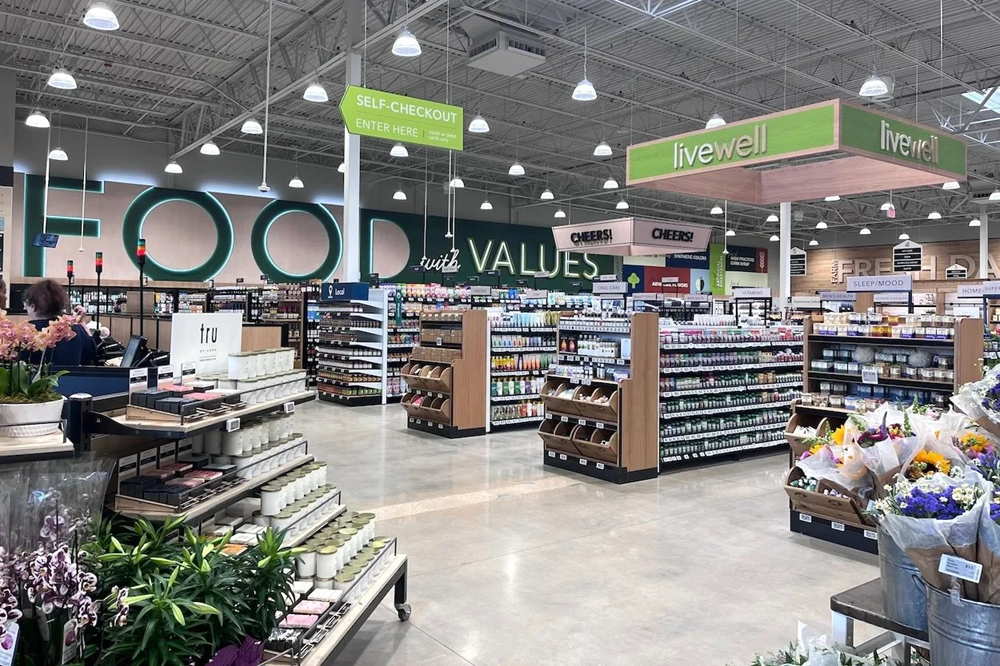
Pegboard display systems provide modular merchandising solutions through perforated panel configurations. These commercial fixtures feature standardized hole patterns that accept various hardware accessories, enabling rapid product arrangement modifications without structural alterations.
Pegboard Display Features
Pegboard systems utilize perforated panels with uniform hole spacing for accessory compatibility. The modular construction incorporates standardized mounting points that accommodate hooks, brackets, and specialized hardware for product display configurations. These fixtures support immediate layout modifications for promotional campaigns or inventory changes without requiring permanent installations. Vertical mounting maximizes wall space utilization while preserving floor area for customer traffic. The system architecture enables clean merchandise presentations through organized product grouping methods.
Pegboard Display Materials
Multiple material specifications serve different operational requirements. Wood pegboard panels provide traditional appearance characteristics suitable for specialty retail environments. Metal versions utilize steel or aluminum construction, offering enhanced load capacity and structural durability for heavy merchandise applications. Plastic pegboard options deliver lightweight installation with moisture-resistant properties for humid storage conditions. Epoxy resin pegboards with fiber reinforcement provide maximum durability specifications for demanding commercial applications requiring chemical resistance.
Pegboard Display Placement
Wall-mounted installations optimize vertical merchandising space in retail environments. These systems perform effectively on perimeter walls, utilizing previously unused display areas. High-visibility wall sections near store entrances serve as primary product showcase zones for customer attention. Cross-merchandising installations position complementary products in proximity, encouraging multiple-item purchases.
Pegboard Display Sales Impact
Organized pegboard installations influence customer purchasing behavior through improved product accessibility. Systematic merchandise arrangement reduces customer navigation effort, directing attention toward products rather than store layout complexity. Performance data indicates pegboard displays can generate sales increases reaching 540% in optimal configurations. These systems enhance shopping efficiency through clear product visibility and organized presentation methods.
Fruits & Vegetable Display Stands
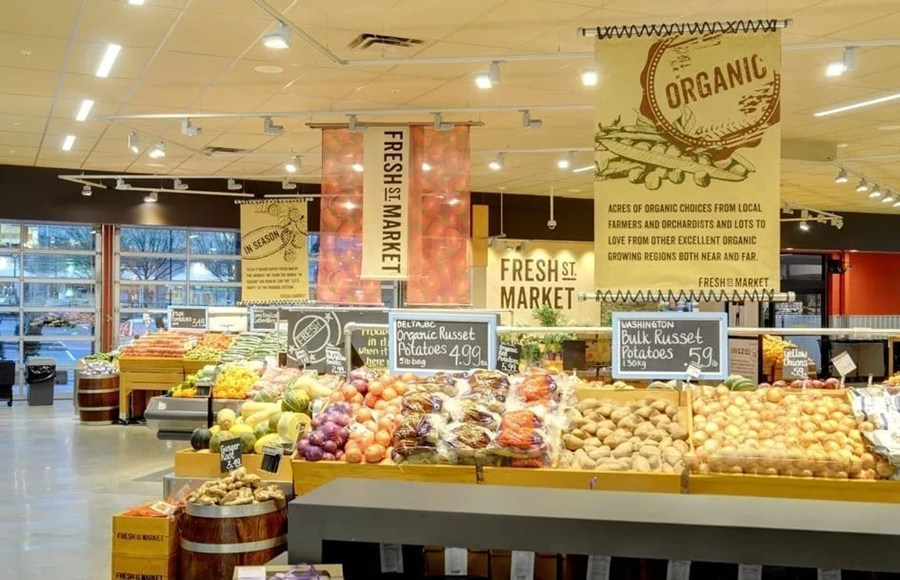
Produce display fixtures function as specialized merchandising units designed to maximize product visibility while maintaining freshness standards. These commercial-grade display stands utilize strategic design elements to enhance product presentation and drive customer engagement in grocery environments.
Fruit & Veg Stand Features
Contemporary produce fixtures incorporate modular configurations that accommodate seasonal inventory adjustments and merchandising priorities. Standard specifications include tiered riser systems and waterfall display mechanisms that position merchandise at optimal viewing levels while minimizing product stacking requirements. Height-adjustable mobile units enable configuration flexibility for varying product dimensions. Surface angles range from horizontal to 40-degree inclines to optimize visibility while preventing product damage. Integrated drainage systems support maintenance requirements for produce hydration protocols.
Fruit & Veg Stand Materials
Construction materials are selected based on durability requirements and visual presentation standards:
- Wood Construction: Pine and Chinese fir materials provide an authentic market aesthetic that appeals to customers seeking traditional shopping experiences.
- Steel Framework: Metal structural components ensure stability for multi-tier display configurations.
- Composite Systems: Wood-metal combinations balance visual appeal with structural performance through metal support columns and wooden display surfaces.
Premium fixture specifications feature steel structural frameworks with wood accent elements to maintain durability while achieving the desired visual presentation.
Fruit & Veg Stand Placement
Optimal positioning requires high-traffic locations with appropriate environmental conditions for product preservation. Establishments without specialized refrigeration systems benefit from fixture placement in areas with consistent customer flow to maintain inventory turnover. Central island configurations provide 360-degree customer access for maximum browsing opportunities. Mobile fixture capabilities enable adaptive floor plan configurations that respond to seasonal merchandising requirements.
Fruit & Veg Stand Sales Impact
Strategic produce presentations generate impulse purchase behavior through visual merchandising techniques. Research demonstrates that organized color presentations extend customer engagement time in produce departments. Extended browsing periods correlate with increased unplanned purchase activity. Color-coordinated display arrangements effectively reduce customer movement speed and encourage product interaction leading to sales conversion.
Refrigerated Display Cases
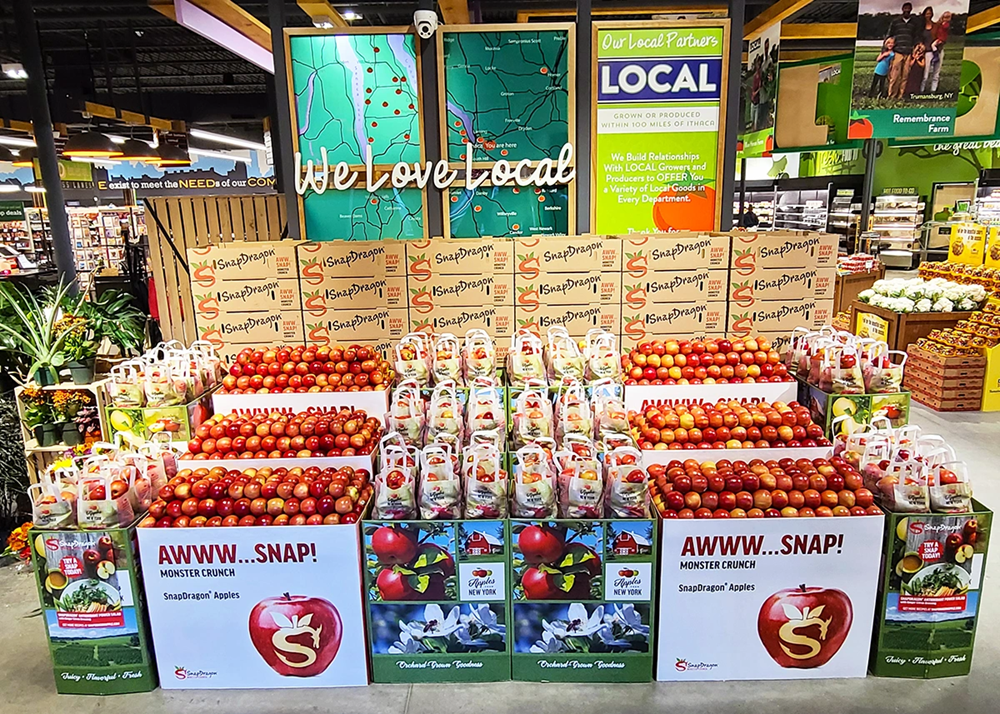
Refrigerated display cases provide temperature-controlled merchandising solutions for perishable grocery products. Operating specifications maintain consistent temperatures between 33°F and 41°F to meet food safety regulations and extend product shelf life. These commercial fixtures combine product preservation with customer accessibility requirements.
Refrigerated Case Features
Current refrigerated display configurations include open-air merchandisers, glass door cases, and specialized bakery units for commercial installations. Self-contained systems integrate condensing units and evaporator coils within the fixture assembly. Remote systems connect to external refrigeration equipment for larger installations. Standard units measure 24-78 inches wide with adjustable shelving configurations. Technical specifications include:
- LED lighting systems for enhanced product visibility
- Electronic temperature controllers with digital monitoring
- Automatic defrost timers with high-temperature alerts
- Vertical folding door mechanisms for security applications
Refrigerated Case Materials
Construction materials accommodate continuous temperature cycling requirements. Stainless steel exteriors provide commercial-grade durability. Aluminum and painted steel alternatives offer cost-effective options. Interior finishes utilize stainless steel or ABS materials for sanitation compliance. Transparent components require specialized materials—PETG and polycarbonate maintain optical clarity while providing superior insulation properties compared to standard glass. HDPE materials serve interior wall applications due to stain-resistance and temperature stability.
Refrigerated Case Placement
Installation positioning affects operational performance and sales results. Units require placement away from heating vents, appliances, and direct sunlight to maintain temperature control. Open-case refrigeration systems need adequate airflow around exhaust vents to prevent compressor failure. Store entrance positioning creates visual impact for refrigerated produce displays. Essential dairy products benefit from placement near restocking areas to reduce employee handling requirements.
Refrigerated Case Sales Impact
Refrigerated display implementation generates measurable sales increases. Self-service configurations increase sales by 50% minimum through improved product accessibility. Proper lighting systems enhance perceived food quality and customer purchase decisions. Combination cases featuring refrigerated and ambient temperature sections maximize space efficiency while promoting complementary purchases.
Bulk Bins

Bulk dispensing systems provide retailers with customizable merchandising solutions that allow precise quantity selection while reducing packaging overhead costs. These interactive fixtures convert traditional retail spaces into self-service zones that accommodate diverse product categories.
Bulk Bin Features
Commercial bulk installations incorporate two standard dispensing mechanisms. Gravity-fed systems utilize lever-activated release handles optimized for free-flowing products, including beans, coffee, and nuts. Scoop-access bins accommodate adhesive or irregular-shaped merchandise. Both configurations maintain first-in-first-out inventory rotation protocols for consistent product freshness. Advanced installations include integrated nut butter grinding stations for on-site processing. Large-format retail operations typically maintain 400+ bulk SKUs spanning grains, flours, herbs, and personal care items.
Bulk Bin Materials
Commercial-grade bulk fixtures require FDA-approved resins to meet food safety compliance standards. Professional units feature dishwasher-safe construction rated for commercial cleaning cycles up to 180°. Material specifications prioritize scratch-resistant and stain-resistant properties for extended service life. Quality bulk dispensers maintain operational efficiency for a minimum of 10-year service periods.
Bulk Bin Placement
Entrance-adjacent bulk sections create immediate visual engagement for incoming customers. Department-specific lighting systems differentiate bulk areas from standard merchandising zones. Full-capacity bins maintain customer attraction through a visual abundance presentation.
Bulk Bin Sales Impact
Bulk merchandise generates profit margins 10-30% above packaged product alternatives. Customer quantity control reduces waste while providing cost savings. Bulk spicing demonstrates significant price advantages—$0.25 bulk pricing versus $4.00 packaged equivalents. Sustainable packaging reduction attracts environmentally-focused customer segments.
Specialty Displays
Specialty display fixtures provide customized merchandising solutions that extend beyond standard supermarket shelving configurations. These specialized units create interactive retail environments designed to increase customer engagement and drive revenue performance.
Specialty Display Features
Custom display systems incorporate interactive technology, including video screens, touch-enabled interfaces, and smartphone-compatible applications. Advanced lighting systems highlight specific products while reducing standard store illumination effects. Non-rectangular fixture designs include round bins, multi-sided display sleeves, and euro-style presentation tables that break conventional square display patterns. Gravity-feed mechanisms enable product placement in non-traditional locations such as cooler tops adjacent to checkout areas.
Specialty Display Materials
Material specifications depend on durability requirements and presentation objectives. Acrylic construction provides transparent surfaces suitable for premium merchandise display. Corrugated cardboard offers economical solutions for temporary installations and seasonal promotions with high customization capability. Metal and wood construction creates upscale presentations for specialty merchandise categories with higher price points. Hybrid material combinations utilize multiple components to achieve optimal durability and visual appeal specifications.
Specialty Display Placement
High-traffic area placement maximizes fixture exposure and operational effectiveness. Cross-merchandising configurations encourage complementary product purchases through strategic product pairing. The checkout counter and service desk proximity capitalizes on customer waiting periods to increase impulse purchase opportunities. End-cap specialty installations receive up to 93% greater exposure compared to standard shelf positions.
Specialty Display Sales Impact
Custom display implementations yield measurable sales increases across multiple categories. Research data indicates that all specialty display types generate a positive revenue impact. Front-end cap specialty displays show the greatest influence on category-level purchases, while shelf displays significantly affect brand selection patterns. Interactive displays featuring product demonstrations increase trial rates by 92% for featured brands. Specialty display productivity often exceeds traditional end cap performance by two to three times.
Checkout Shelving

Checkout shelving systems occupy premium retail positions during the final purchase moments. Research data indicates 87% of US shoppers complete impulse purchases at checkout counters. These fixtures represent critical merchandising opportunities in retail store configurations.
Checkout Shelving Features
Checkout displays utilize compact configurations that maximize counter space efficiency. Single-sided display arrangements face customers directly during queue waiting periods. Tiered fixture designs create multiple product surfaces without expanding footprint requirements. Three-tier acrylic configurations accommodate varied product categories—chocolates positioned at base level, mints at middle tier, promotional items at top section. Clear container systems complement display setups, providing product visibility and selection accessibility.
Checkout Shelving Materials
Material selection prioritizes durability and visual presentation standards. Steel framework construction ensures structural stability during customer interactions [9]. Acrylic display components maintain visibility requirements while meeting cleanliness standards [9]. Material specifications withstand frequent handling while maintaining purchase appeal.
Checkout Shelving Placement
Optimal placement positions products at the customer’s eye level or card reader proximity. Positioning below sight lines or lateral placement reduces customer interaction rates. Self-checkout configurations incorporate dedicated product sections at eye-level arrangements.
Checkout Shelving Sales Impact
Customer behavior studies document 70% of impulse purchases occur in checkout zones during payment waiting periods. Products priced below $20 demonstrate optimal performance due to minimal purchase consideration requirements. Popular checkout items include M&Ms (36% consumer preference), candy bars, gum, and bottled water products.
Island Shelving
Island shelving units occupy central aisle positions as freestanding display fixtures. These double-sided structures enable customer access from multiple angles, maximizing product exposure compared to wall-mounted alternatives.
Island Shelving Features
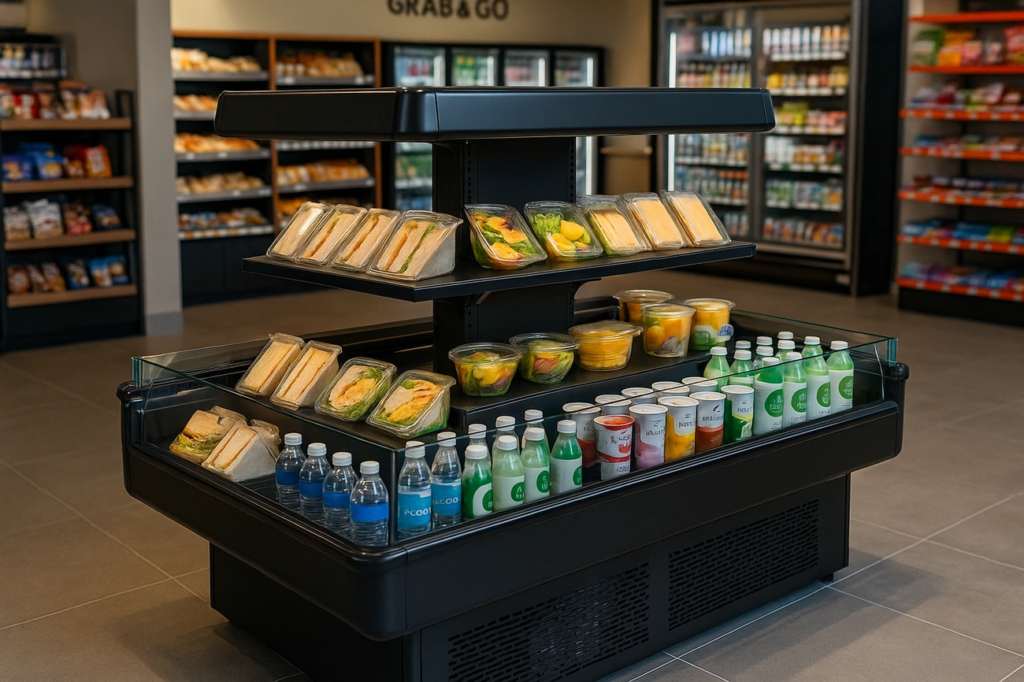
Island displays provide 360-degree merchandise access, increasing product visibility. Adjustable shelf configurations accommodate various item dimensions and weight requirements. High-capacity units support up to 10,000 pounds of merchandise. Advanced models incorporate deep drawer systems and tall cabinet sections designed for kitchen accessories and cookware storage. Standard features include wood ticket molding compatible with 1-1/4″ price tags and information strips.
Island Shelving Materials
Commercial-grade metal frameworks form the structural base for island units, ensuring operational stability and extended service life. Heavy-duty metal shelving surfaces support substantial weight loads. Wood accent components include real wood back panels and bin shelves featuring multiple cubby configurations. Premium specifications feature dovetailed solid hardwood drawers with full extension undermount soft-close slide mechanisms.
Island Shelving Placement
Central store positioning creates multiple customer traffic patterns around island fixtures. Freestanding design allows flexible placement for seasonal promotions and high-demand merchandise. Double-sided configurations maximize display capacity while maintaining efficient space utilization. High-visibility locations optimize these units as promotional focal points.
Island Shelving Sales Impact
Open access design facilitates product selection, creating positive shopping experiences that encourage additional purchases. Seasonal promotion displays using island units generate increased customer attention and store traffic. Strategic central placement improves overall store navigation and customer flow patterns.
Corner Shelving
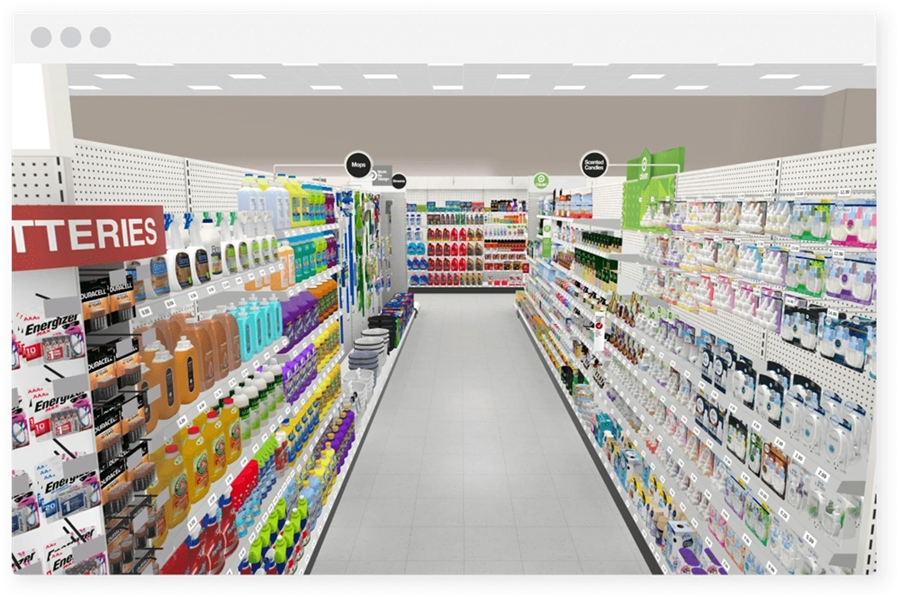
Corner shelving systems address spatial inefficiencies found in retail floor plans. These angular display units maximize unused corner areas while maintaining store layout continuity.
Corner Shelving Features
Corner shelving configurations utilize angled design principles to accommodate irregular floor spaces. Single and double-sided options are manufactured to meet varying store requirements. Premium units incorporate tempered glass panels, adjustable shelf positions, and locking mechanisms for secure merchandise storage. LED spotlights and integrated lighting systems are installed to enhance product visibility in corner locations.
Corner Shelving Materials
Mild steel construction provides structural stability for corner unit applications. Powder coating treatments are applied during manufacturing to prevent corrosion and extend service life. Mirror back panels, aluminum trim components, and laminate finishes are available for enhanced visual presentation.
Corner Shelving Placement
Corner units are positioned at internal and external corner intersections throughout retail establishments. These fixtures connect showcase displays and cash wrap counters into continuous merchandising systems. Installation eliminates dead zones commonly found in standard rectangular shelving layouts.
Corner Shelving Sales Impact
Corner shelving installations improve customer traffic flow patterns through previously underutilized areas. Proper implementation converts corner spaces into active merchandising zones that contribute to overall sales performance.
Wall-Mount Cigarette Shelves
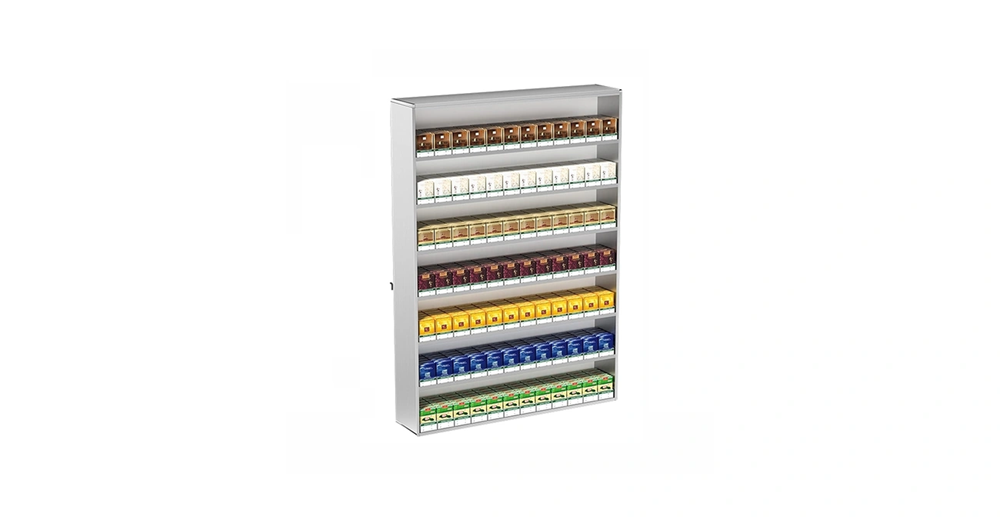
Wall-mounted cigarette display systems provide regulatory-compliant storage solutions for controlled tobacco merchandise. These specialized fixtures meet security requirements while maintaining staff accessibility for product retrieval.
Cigarette Shelf Features
Commercial cigarette shelving systems incorporate spring-loaded pusher mechanisms that maintain front-facing product positioning, preventing a stock-out appearance. Polycarbonate door construction replaces traditional glass components, offering enhanced durability with transparent visibility. Automated closure systems feature soft-close hinge mechanisms for continuous security operation. Standard configurations include:
- Color-coded identification systems for product categorization
- Push-feed track systems for consistent merchandise presentation
- Internal dividers for clerk selection accuracy
Cigarette Shelf Materials
Construction specifications utilize wood-grain laminate materials combined with acrylic transparency components [38]. Premium models feature solid wood back panel construction with integrated price tag molding systems accommodating 1-1/4″ signage strips. Steel framework construction employs hand-welded assembly with textured black powder coating finish for extended operational life.
Cigarette Shelf Placement
Installation positioning requires compliance with retail regulations and operational efficiency standards. Height specifications maintain 120-140 cm floor clearance for staff accessibility and security protocols. Regulatory compliance mandates placement behind checkout counter areas, prohibiting self-service customer access.
Cigarette Shelf Sales Impact
Strategic display configuration affects transaction efficiency and additional purchase decisions. Eye-level merchandise positioning reduces selection time while encouraging supplementary product purchases. Lighting specifications require a 4,000-5,000K color temperature range to prevent product color distortion and clerk selection errors. LED illumination systems maintain 300-400 lux brightness levels without glare interference.
Single-Side Gondola Shelving
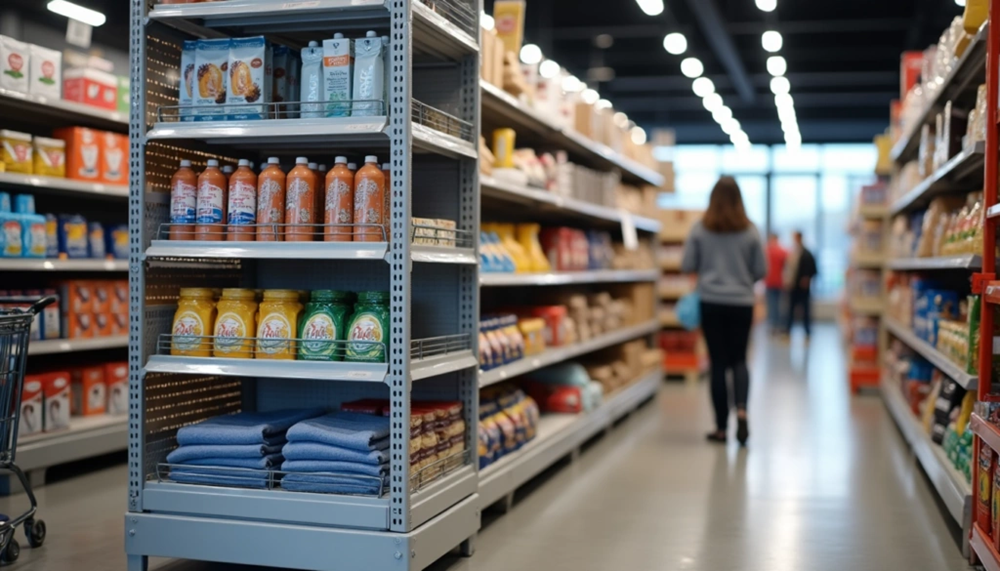
Single-side gondola shelving systems deliver space-efficient solutions for perimeter retail installations. These wall-mounted fixtures optimize vertical merchandising capacity while maintaining accessible product presentation for grocery store operations.
Single-Side Gondola Features
Single-sided gondola configurations provide unidirectional product access through steel upright construction. Slot positioning at 1-inch intervals enables precise shelf height adjustments. Commercial specifications support merchandise loads up to 2100 pounds per unit. Standard base shelf depth measures 19 inches, accommodating substantial product volumes within compact floor plans. Integrated signage systems attach directly to slotted uprights using secure plastic clip mechanisms.
Single-Side Gondola Materials
Steel upright construction ensures structural durability for heavy-duty retail applications. Base shelf components utilize powder-coated steel finishes for corrosion resistance during extended operational periods. Birch back panel installation provides structural support and visual enhancement. Material options include unfinished wood for cost-effective installations or custom-stained finishes for premium store environments.
Single-Side Gondola Placement
Perimeter wall installations maximize floor space utilization while establishing defined store boundaries. Compact retail environments benefit from single-sided gondola frameworks as primary structural elements. Flush wall mounting creates ca ontinuous visual flow throughout shopping areas. Pharmacy and specialty department applications reserve central floor areas for alternative merchandising while maintaining comprehensive product display.
Single-Side Gondola Sales Impact
Strategic perimeter placement maximizes vertical display opportunities without consuming valuable center floor space. Organized product presentation enhances merchandise accessibility and customer navigation efficiency. Defined shopping pathways along store perimeters improve overall customer flow patterns throughout retail establishments.
Technical Specifications Comparison
| Fixture Type | Primary Features | Construction Materials | Installation Location | Performance Metrics |
|---|---|---|---|---|
| Gondola Shelving | – Quick-adjust functionality – Height range: 36″-120″ – Max shelf depth: 30″ | – Cold-rolled steel – Wood components (finger joint boards, MDF) – Acrylic/PVC accessories | Central aisles with clear navigation paths | – Eye-level products boost sales by 23% – Endcap displays generate 10-20% higher sales |
| Wall Shelving | – Single-sided display – Heavy weight capacity – Vertical space maximization | – Steel (primary) – Wood (premium option) – Steel with wood-look finishes | Store perimeters and along walls | Products at eye level generate significantly higher sales |
| End Cap Displays | – Three-component design – Interactive elements – QR codes/touchscreens | – Corrugated cardboard – Plastics (acrylic, PVC) – Metal or wood | Aisle ends with 93% more exposure | Can increase sales by 32% or more |
| Pegboard Displays | – Modular design – Customizable layouts – Quick layout changes | – Wood – Metal (steel/aluminum) – Plastic – Epoxy resin | Prominent wall areas near entrances | Can increase sales by up to 540% |
| Fruits & Vegetable Stands | – Tiered risers – Waterfall displays – Adjustable heights | – Wood (pine/Chinese fir) – Steel frameworks – Hybrid wood-metal combinations | High-traffic areas with appropriate temperature conditions | Increases shopping time in produce sections |
| Refrigerated Display Cases | – Temperature control (33°F-41°F) – LED lighting – Electronic controllers | – Stainless steel – PETG/polycarbonate – HDPE for interior | Away from heat sources and direct sunlight | Self-service displays increase sales by 50% |
| Bulk Bins | – Gravity or scoop dispensing – First-in-first-out rotation – 400+ item capacity | FDA-approved resins | Near store entrances | 10-30% higher profit margins than packaged alternatives |
| Specialty Displays | – Interactive capabilities – Video screens – Touch technology | – Acrylic – Corrugated cardboard – Metal and wood hybrids | High-traffic areas and near checkout | 2-3 times more productive than traditional end caps |
| Checkout Shelving | – Compact dimensions – Tiered arrangements – Clear bins/containers | – Steel frame – Acrylic displays – Plastic components | Eye level or near card readers | 87% of US shoppers make impulse purchases |
| Island Shelving | – 360-degree access – Adjustable shelves – Up to 10,000 lbs capacity | – Commercial-grade metal – Wood accents – Hardwood drawers | Store centers and high-visibility locations | Enhances impulse purchases through improved access |
| Corner Shelving | – Single/double-sided options – Adjustable shelves – LED lighting options | – Mild steel – Powder coating – Aluminum trim | Internal or external corners | Improves customer flow and store navigation |
| Wall-Mount Cigarette Shelves | – Spring-loaded pushers – Automatic closing – Color-coded systems | – Wood-grain materials – Acrylic components – Hand-welded steel frames | Behind checkout counters, 120-140cm from floor | Eye-level placement increases selection speed |
| Single-Side Gondola Shelving | – 1-inch interval slots – 2100 lbs capacity – 19-inch deep base | – Steel uprights – Powder-coated steel – Birch back panels | Store perimeters and walls | Enhances merchandise visibility and navigation |
Technical Summary
Shelving system selection determines retail operational efficiency and revenue performance metrics. Each fixture category addresses specific merchandising requirements—gondola systems establish store infrastructure while specialized displays target customer engagement objectives. Store operators implementing systematic fixture analysis achieve measurable competitive advantages.
Placement protocols directly influence sales conversion rates. Eye-level product positioning generates 23% sales increases compared to alternative locations. End-cap installations capture 93% additional customer exposure versus standard shelf configurations, supporting premium promotional pricing strategies.
Material specifications affect both operational longevity and customer perception factors. Steel construction provides superior load-bearing capacity for heavy merchandise categories. Wood components establish warmer retail environments that extend customer dwell time. Hybrid material combinations optimize structural performance while maintaining visual appeal.
Fixture systems function beyond storage applications—they facilitate improved store navigation and reduce customer decision fatigue. Organized product presentations enable focused shopping behavior, resulting in extended visit duration and increased transaction values.
Technology integration enhances fixture functionality through LED illumination systems and electronic temperature controls for refrigerated units. Interactive components, including QR code systems and touchscreen interfaces, drive impulse purchase behavior.
Investment analysis requires the evaluation of the immediate sales impact against long-term operational costs. Premium fixture specifications typically provide extended service life and superior merchandising capabilities. Specialty display systems command higher initial costs but generate 200-300% performance improvements versus conventional alternatives.
Store operators benefit from systematic fixture comparison during layout planning or renovation projects. The detailed specifications provided enable informed selection based on specific operational requirements and customer demographics.
Modern grocery retailers recognize shelving systems as active sales tools rather than passive storage solutions. These fixtures function as continuous marketing instruments that influence customer behavior and purchasing decisions throughout the shopping experience.
Key Takeaways
Strategic shelving selection and placement can dramatically transform your grocery store’s sales performance and customer experience.
• Eye-level placement drives sales: Products positioned at eye level boost sales by up to 23%, while end cap displays generate 10-20% higher sales than standard shelf facings.
• Material choice impacts durability and perception: Steel provides exceptional strength for heavy items, while wood creates inviting environments that encourage longer shopping sessions.
• Specialty displays outperform traditional fixtures: Interactive displays and specialty fixtures generate 2-3 times higher sales than conventional end caps through enhanced customer engagement.
• Strategic placement maximizes visibility: End caps receive 93% more customer exposure than standard shelf positions, making them prime real estate for promotions.
• Refrigerated displays boost impulse purchases: Self-service refrigerated cases increase sales by 50% through easy product access and enhanced visibility.
The right combination of shelving types, materials, and placement creates a seamless shopping experience that reduces customer effort while maximizing product visibility. From gondola shelving forming your store’s backbone to checkout displays capturing last-minute purchases, each fixture type serves a specific role in driving revenue growth and customer satisfaction.
FAQs
Q1. What types of grocery store shelves are most effective for boosting sales? End cap displays, refrigerated cases, and specialty displays tend to be most effective at driving sales. End caps can increase sales by up to 32%, while self-service refrigerated displays can boost sales by 50%. Specialty and interactive displays often generate 2-3 times more sales than traditional fixtures.
Q2. How does product placement on shelves impact sales? Product placement significantly affects sales. Items positioned at eye level can see up to a 23% increase in sales. End cap displays receive 93% more exposure than standard shelf positions, making them ideal for promotions and high-margin items.
Q3. What materials are best for grocery store shelving? The best materials depend on the specific shelving type and purpose. Steel is commonly used for its durability and strength, especially for heavy items. Wood or wood-look finishes create a warmer aesthetic. For refrigerated displays, materials like stainless steel, PETG, and polycarbonate are often used for their durability and insulating properties.
Q4. How can grocery stores maximize sales through strategic shelf placement? Strategic shelf placement involves positioning high-margin items at eye level, using end caps for promotions, placing impulse purchase items near checkouts, and creating logical product groupings. Stores should also consider traffic flow, ensuring popular items are easily accessible while encouraging customers to explore less-visited areas.
Q5. What role do technology and interactive elements play in modern grocery store shelving? Technology and interactive elements are increasingly important in grocery store shelving. LED lighting enhances product visibility, while electronic controllers maintain optimal temperatures in refrigerated cases. Interactive displays with touchscreens or QR codes can engage customers and provide additional product information, potentially increasing sales by creating more engaging shopping experiences.

